Both PSG and Monaco, although the latter to a lesser extent, are still in with a chance of pipping top-of-the-table Lille to the Ligue 1 title as we approach the season finale on Sunday. These sides could get their hands on some silverware before then too, as they’ll contest la finale de la Coupe de France on Wednesday evening.
PSG have won the Coupe de France 13 times – more than any other club. They’ve also claimed five of the last six Coupe de France titles, appearing in each of the last six finals. With Wednesday’s game making it seven straight Coupe de France finals for Les Parisiens, they’re in familiar territory. Monaco have appeared in just one final since last winning this competition in 1991, which was their fifth time lifting the trophy. Les Monégasques can end a 30-year drought this week.
Despite the disparity between the two sides’ recent success, Monaco deserve better than to be portrayed as simply ‘the underdog’ for this. In addition to sitting just two points behind PSG in Ligue 1, former Bayern Munich boss Niko Kovač has led his side to two wins from two over Les Parisiens in his first season at Stade Louis II.
You could argue that PSG have something to prove given their recent fortunes versus Monaco and the fact that Wednesday may give Paris their best chance of avoiding a trophyless season for the first time since 2011/12. With that in mind, it’s understandable why Kovač has declared that former Tottenham Hotspur manager Mauricio Pochettino’s side are “under pressure” heading into Wednesday’s game.
In this tactical analysis, in the form of a tactical preview, we’ll provide analysis of some significant aspects of both PSG and Monaco’s tactics. Our tactical analysis will highlight some potential keys to victory for both sides, while we’ll also reflect on their previous two meetings this season.
PSG’s defence
PSG have primarily lined up in a 4-2-3-1 since Pochettino’s arrival at Le Parc des Princes. This formation is a staple of Pochettino teams. Another essential tactical aspect of the Argentinian’s sides is aggressive pressing, and this has also been evident in his PSG side since his January arrival.
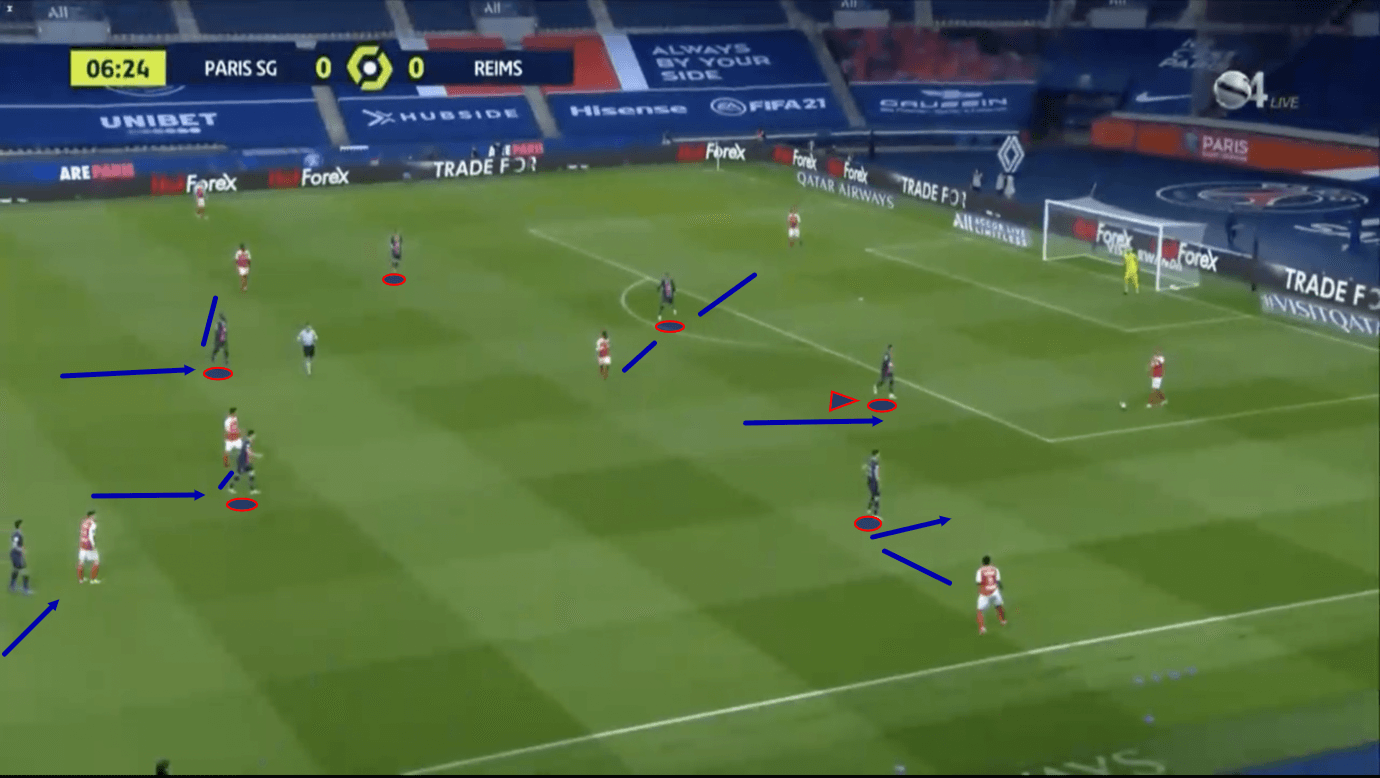
Figure 1 shows PSG pressing as the opposition build out from the back. Under Kovač, Monaco like to build out from the back via short passing, so this is a sight we may see plenty of on Wednesday. PSG operate with a very high line of engagement. As soon as this goal kick is taken and the ball is played out to the left centre-back, PSG ‘s ‘number 10’, Neymar, initiates the press, while keeping the opposition’s holding midfielder in his cover shadow.
Centre-forward Kylian Mbappé also retains access to the holding midfielder, along with the right centre-back should the opposition look to switch play. Right-winger Ángel Di María retains access to the ball-side opposition full-back, though doesn’t block off that pass entirely, while the holding midfield duo advance while marking opposition midfielders. At this stage, PSG’s primary focus is on preventing the opposition from playing through the centre of the pitch, as this area provides a more direct route to goal, and players in the centre have a greater area of the pitch to play into than players on the wings.
By congesting the centre and pressing from there, keeping central players covered while closing in on the ball carrier, PSG often succeed in forcing the opposition out wide. When they get the opposition out wide, they use the extra defender that is the sideline to their advantage. The sideline vastly reduces the area of play that the wide players have available to them and PSG can press with greater intensity.
A lot of their turnovers are forced via aggressive pressing out wide, so this is an area for Monaco to tread carefully on Wednesday, especially considering that PSG are very good at forcing turnovers in advanced areas of the pitch and creating goalscoring opportunities thanks to the frightening pace and elite dribbling quality of the likes of Mbappé and Di María – Monaco are set to be handed a major boost by the absence of Neymar through suspension, however, provided that suspension isn’t overturned.
Still, though, PSG will look to defend like this, forcing Monaco out wide before pressing with aggression, and while they don’t actually have possession in this phase, they are generally very close to being at their most dangerous and creative when pressing in the final third. Monaco will have to be alert mentally, as well as quick, sensible, and accurate with their passing, to avoid conceding these types of chances to a very well organised side off the ball.
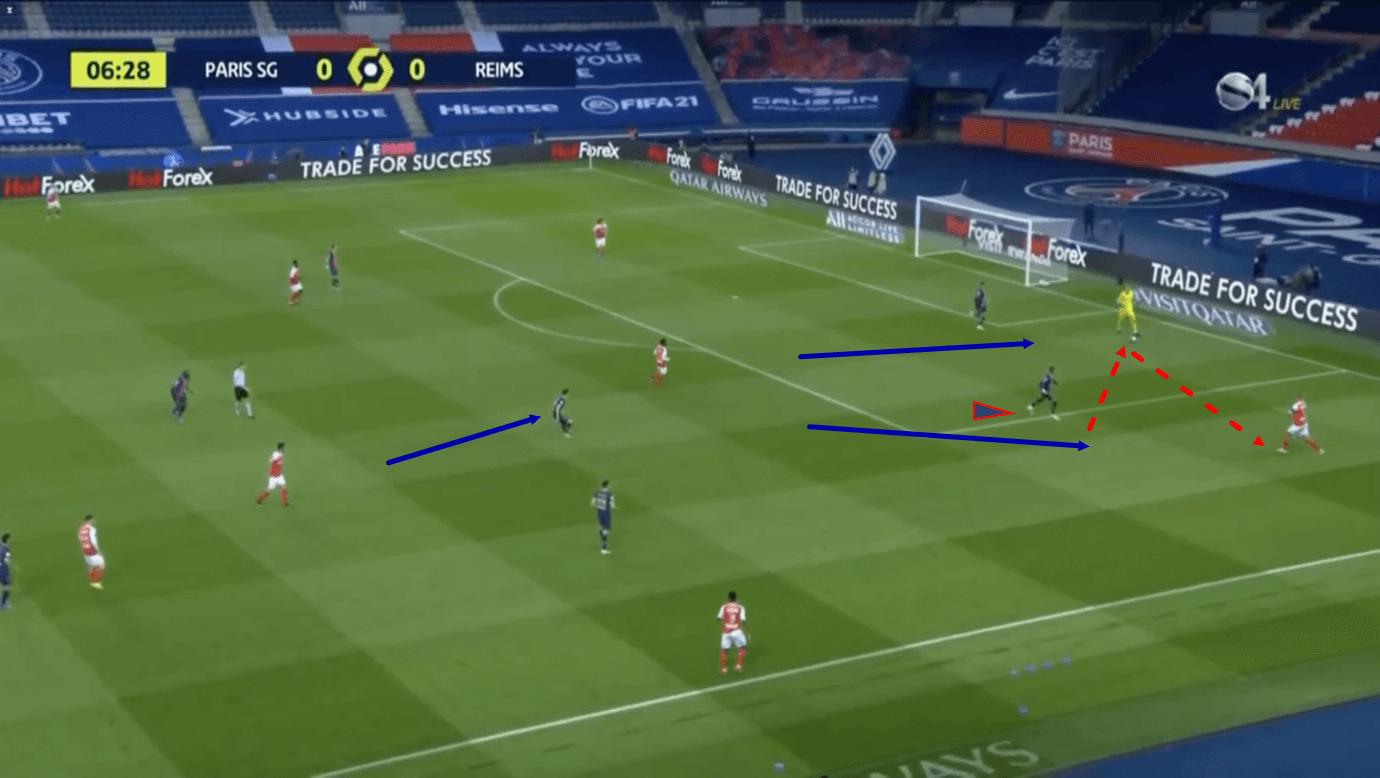
Figure 2 shows that due to PSG’s aggressive pressing and how it cut off near passing options, Reims’ left centre-back was forced to play back to the goalkeeper, to switch play. This didn’t quite go to plan and ultimately just put the ‘keeper under a lot of pressure, however, as lightning-quick Mbappé sprung into action, cutting the passing lane between the ‘keeper and the right centre-back while closing in on him. At the same time, Neymar continued towards the left centre-back who had just been on the ball, as he moved wider to try and get more space and time to potentially receive the ball from the ‘keeper again.
As PSG’s ‘10’ and centre-forward pressed higher, this created more space for the holding midfielder who they were covering while dealing with the centre-backs. To prevent this player from enjoying too much space, one of PSG’s two holding midfielders – right holding midfielder Ander Herrera – pushed up, vacating the more advanced opposition midfielder he had been covering.
PSG like their players to defend high and prioritise covering the closest short passing options. As play moves on, the left centre-back receives possession again and due to the short passing options being cut off and the ‘10’ closing him down aggressively, he sent the ball long, resulting in PSG regaining possession in a deeper area.
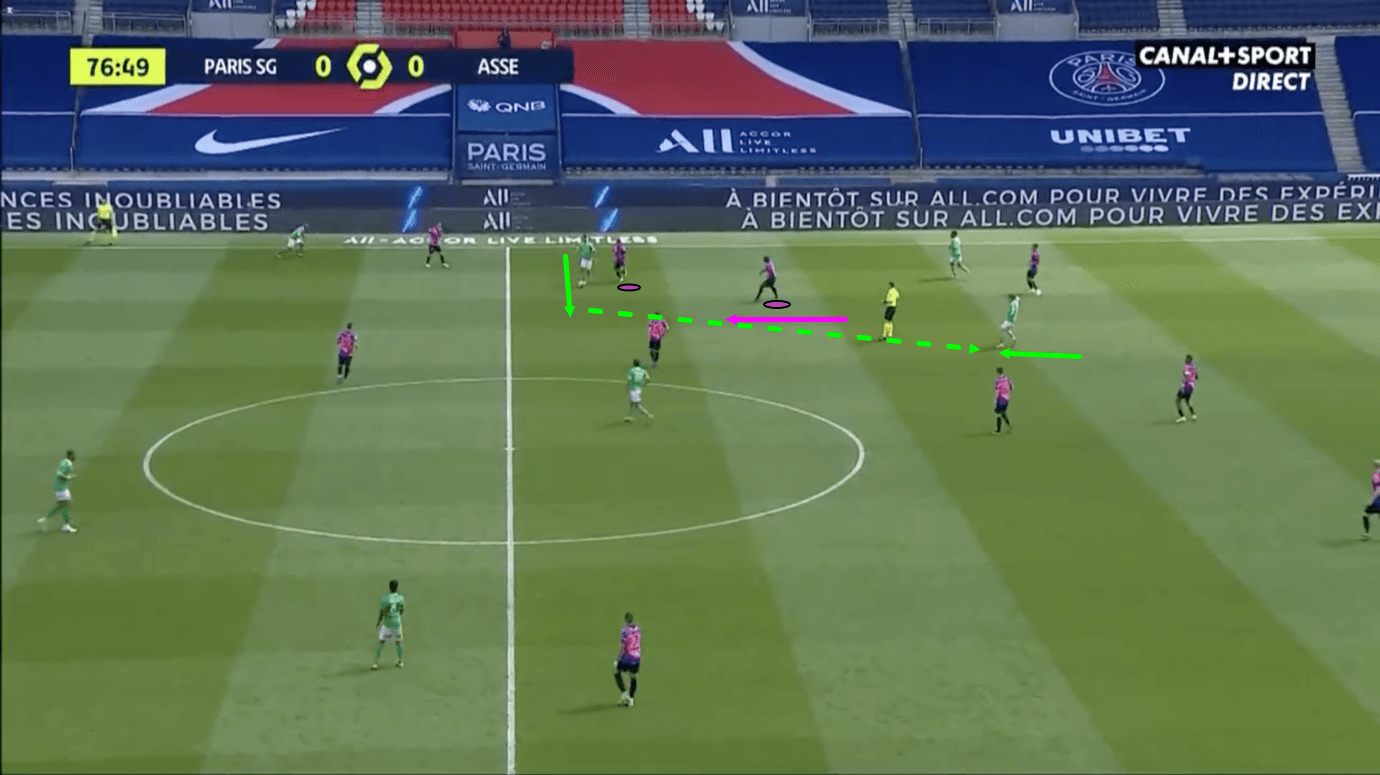
In figure 3, we see that Les Parisiens’ right defensive midfielder advanced from his deeper position as the Saint-Étienne ball carrier dribbled past PSG’s right-back. As mentioned, it’s common for these players to advance and defend higher, but it’s also been common throughout the season for PSG to get punished for this with the opposition exploiting space that opens up between the midfield and defensive lines, which was the case in this example, as an opposition forward dropped to take advantage of the space vacated by PSG’s holding midfielder, making himself a dangerous passing option for the ball carrier.
Monaco will be aware of this area of concern for PSG and likely target it on Wednesday, both when building into PSG’s half in a regular attack, and in transition to attack, as PSG like to counter-press very aggressively and space like this opens up regularly when they counter-press. PSG’s centre-backs will have to be alert and on top of their 1v1 defensive game to counteract this, which they’ve struggled with at times.
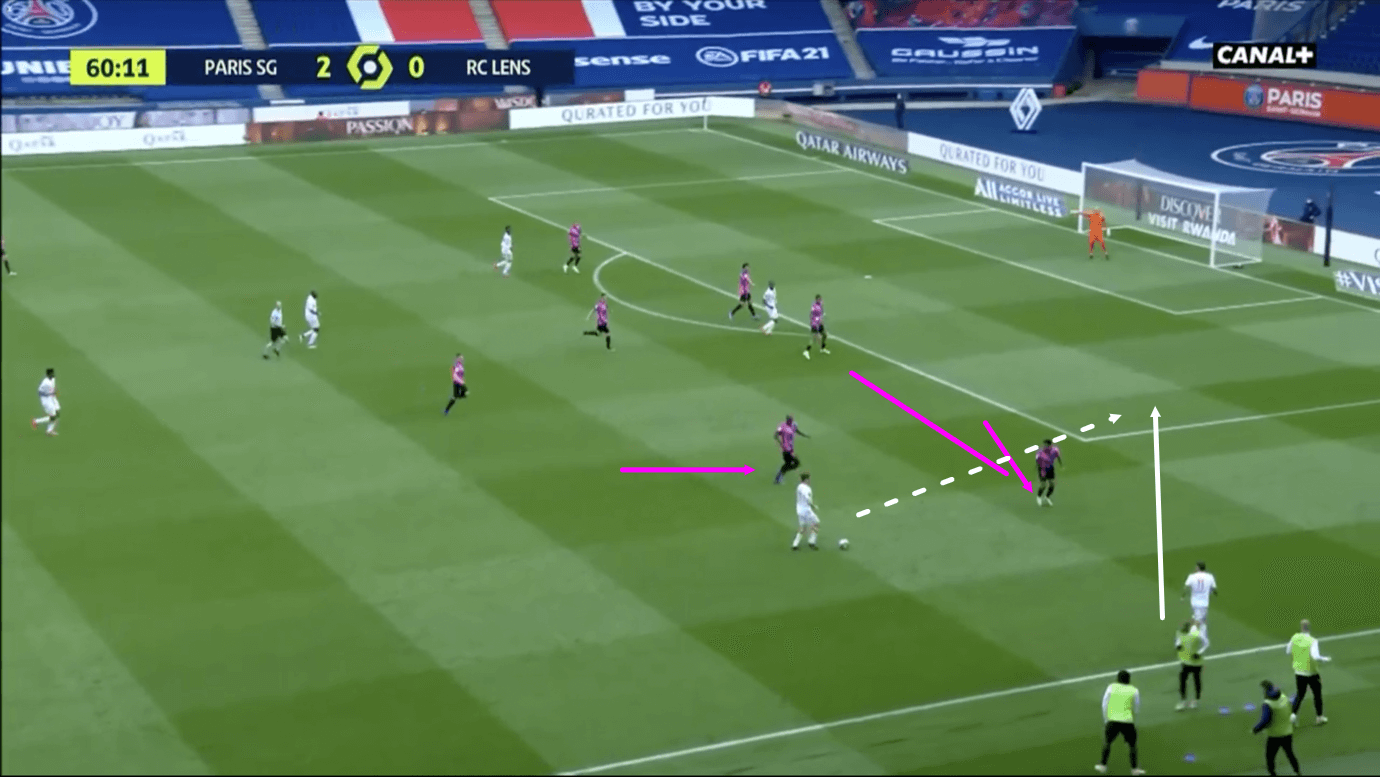
PSG’s full-backs also represent a potential area of concern for Les Parisiens heading into the final. Left-back Layvin Kurzawa is set to miss the game through injury, so Mitchel Bakker will likely start on that side. We could see either Alessandro Florenzi or Colin Dagba on the right. All of these players have had some issues at times this season in situations as we see in figure 4, where Abdou Diallo at left-back was dragged into a more advanced area by the opposition attackers who play past him fairly easily.
Like the holding midfielders, PSG’s full-backs are generally required to defend aggressively and when the opposition advance into areas like this, it’s common for them to get drawn out. This often creates a big gap between them and the nearest centre-back, as they often don’t maintain a close link, while the holding midfielder tends to try and defend higher too, closing down the ball carrier in this example. However, when they fail to close him down effectively, then the large gap between the two defenders can be exploited.
As this passage of play moves on, instead of playing the ball out to the wide man, the ball carrier waits for the wide man to run diagonally in behind the full-back and plays him through on goal. From there, that player can cross from a dangerous position or try and take the ball into a shooting position himself.
Monaco could be wise to try and get the full-backs isolated like this by forcing them into wide areas and doubling up on them, while PSG’s holding midfielders must be more aggressive about preventing this gap from being exploited by closing down the ball carrier quicker and being aware of the passing lane that’s opened up.
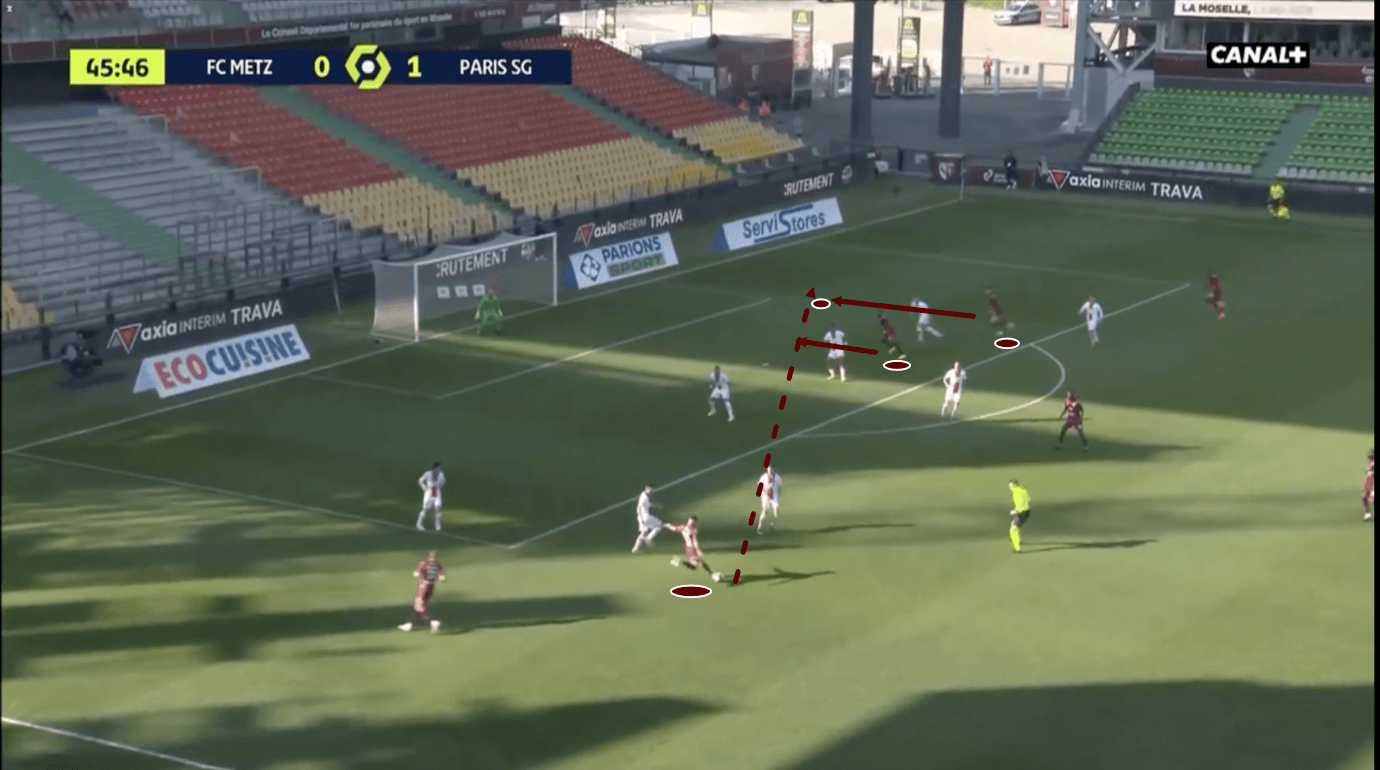
Lastly, another area where PSG’s full-backs have been exploited at times this season is via back-post crosses, which we see an example of in figure 5. PSG’s backline tends to get very narrow inside the penalty area to defend crosses, as one of the full-backs will often be pulled into wide areas to confront the crosser. This can lead to runners getting in behind PSG’s full-backs, getting onto the end of a cross, and scoring, as was the case here.
PSG’s right-backs are also relatively poor in the air, with Florenzi (37.84%) and Dagba (36.84%) among those with the worst aerial duel success rates of any PSG player. Bakker (53.66%) is far better at winning his aerial duels, so perhaps targeting the right-backs at the back post with crosses from the left wouldn’t be a bad strategy for Monaco, however, any opportunity to find runners in behind PSG’s narrow backline will likely be exploited by Monaco.
Monaco’s attack
Monaco have proven themselves capable of exploiting the areas of concern within PSG’s defensive tactics very effectively in their previous meetings this season, and we’ll provide some analysis of how their attacking tactics help them to do that in our next section of analysis. Firstly, however, we’ll look at how Monaco are likely to play during the build-up.
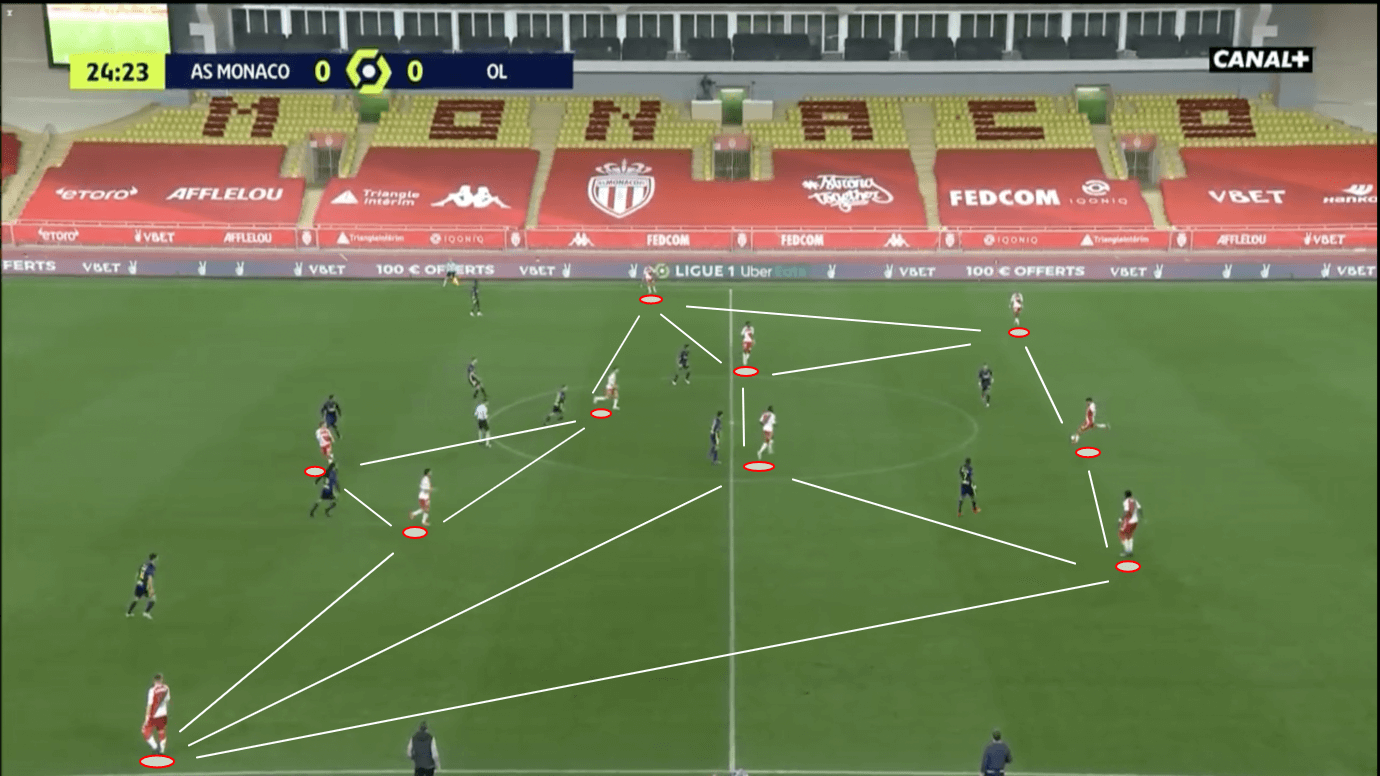
Monaco have used many different formations in the defensive phase throughout the 2020/21 campaign – primarily the 4-4-2, 4-2-3-1, and 3-4-3. We anticipate that they’ll line up in a 4-4-2 or 4-2-3-1 for Wednesday’s clash off the ball, however, on the ball they’ve generally shaped up far more similar to figure 6, regardless of which shape they defend in – a 3-4-2-1. To form this attacking shape from the 4-4-2, one full-back tends to stay deep and tuck in, forming a back three with the centre-backs while the other full-back advances into the midfield line, with the winger on that side pushing into the half-space alongside one striker. Those two attackers will then play off the other striker, who stays central.
This offensive shape allows Kovač’s side to occupy all five channels in the final third and generally retain a numerical superiority in deeper areas with the three centre-backs outnumbering a one or two-man opposition frontline.
Monaco’s wide centre-backs and central midfielders play a key role in ball progression into the opposition half and final third. There will be an interesting battle between Monaco and PSG during this phase of play, with Monaco trying to utilise the central midfielders and wide centre-backs in ball progression and PSG trying to congest the centre of the pitch, blocking off this area, and pressing aggressively when the ball is played to the wide centre-backs.
Like PSG, Monaco are a heavily possession-based side and are happy to be patient and wait for their opening to progress play from the back, but given the aggressive nature of PSG’s press, expect plenty of passes from the wide centre-backs to the full-backs and wingers in the cup final. Monaco may rely on these players’ 1v1 ability versus PSG’s full-backs, while they may also rely on them to find space out wide to help Monaco play around the Paris press if an opening presents itself, though quick and accurate passing will be pivotal in that scenario.
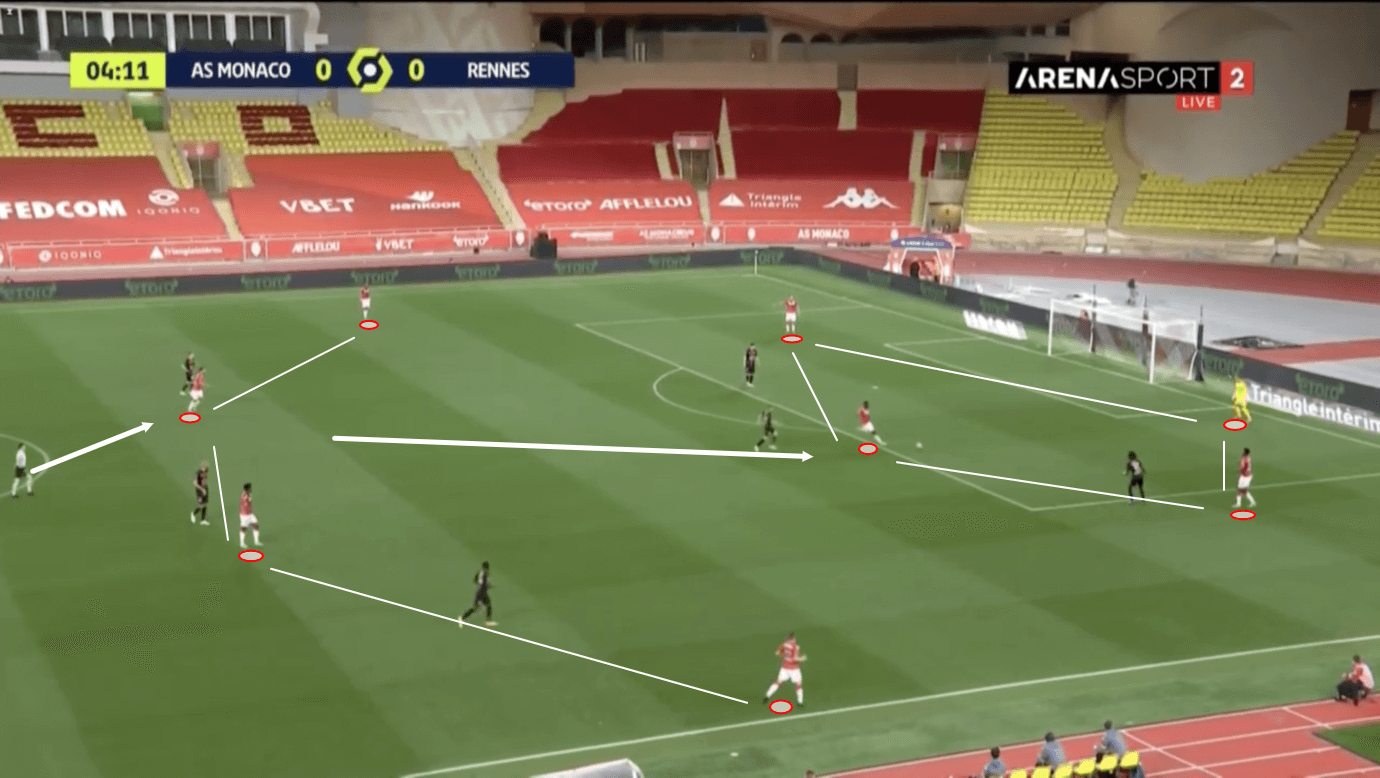
During earlier stages of build-up, Monaco generally shape up as we see them in figure 7, with the full-backs staying wide, one central midfielder dropping and one more advanced player – often one of the centre-forwards – filling his place in central midfield. This movement is different to what we described before, which is how Monaco’s shape develops as they advance slightly further up the pitch, but this still creates Monaco’s 3-4-2-1 shape.
We see Monaco shape up like this far more in games where they take on sides that press aggressively, like PSG, simply because they end up spending more time in this part of the pitch than they do versus sides that press less aggressively and allow Monaco to advance further towards the opposition’s half. Given that we know PSG press aggressively, expect to see Monaco looking like this a lot more often on Wednesday.
It’s worth noting that the full-backs are on the side of the central midfielders closer to their own goal here, whereas, in figure 6, they were on the side closer to the opposition goal. They’ll be making themselves more available for the deeper trio to use as a tool in build-up, rather than a tool to break into the final third, during this early phase of the build-up, which illustrates how they may play a key role in ball progression. Expect to see some patience in the form of lateral passing from Monaco’s deep-lying trio to try and forge their opening into central midfield while drawing PSG’s press, and expect to see them forced into playing the ball out to the full-backs a lot from this situation. From there, PSG’s press will get more aggressive and Monaco’s full-backs will need to be alert and on top of their technical game.
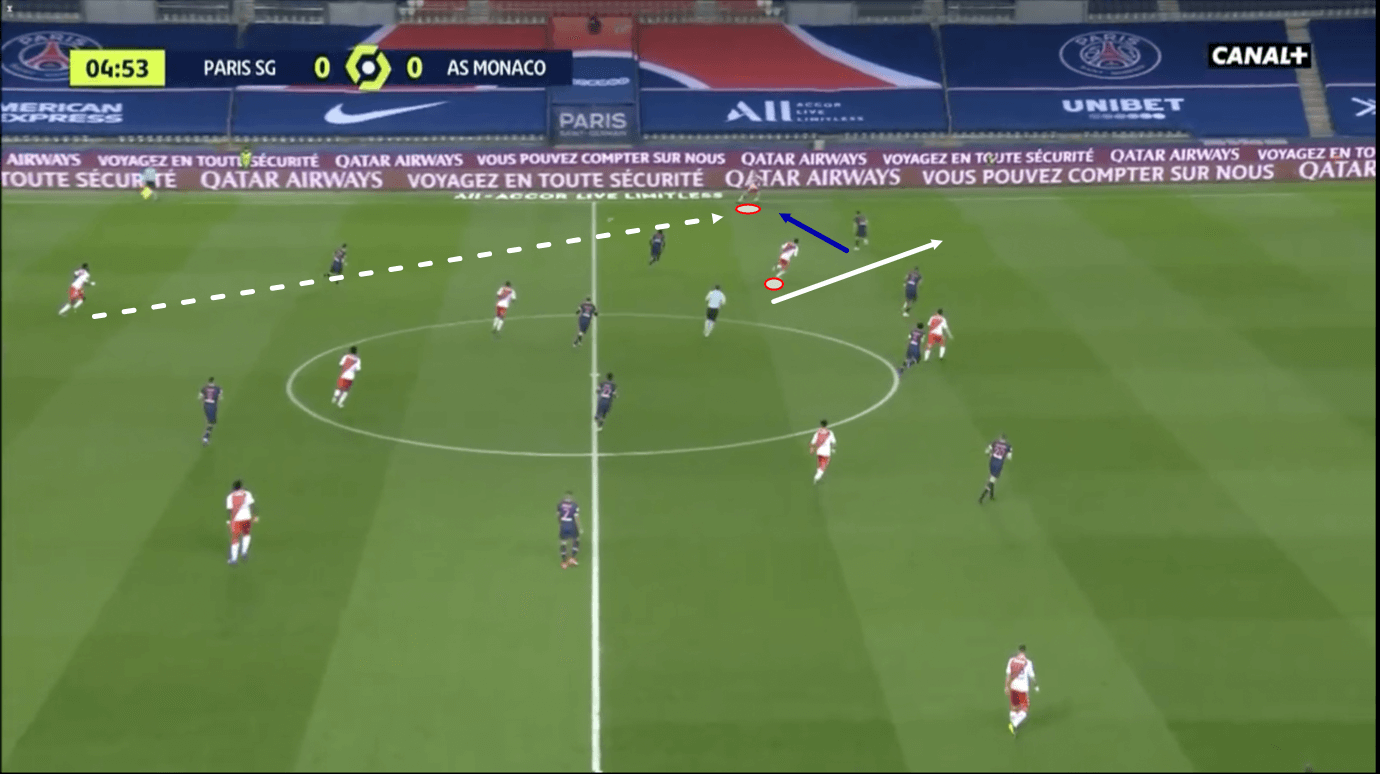
Monaco managed to use their wide men effectively in their 2-0 win at Le Parc des Princes in February while exploiting some of the weaknesses in Pochettino’s side, which we see an example of in figure 8. Here, Monaco’s left centre-back passed to the left-back after finding it difficult to progress via the centre. As the left-back receives the ball, he attracts aggressive pressure from PSG’s right-back.
Monaco’s left-winger in the half-space was alert to this and immediately sprinted into the gap that we discussed before, which we see opening up as the right-back pounces. It would have been possible for the ball receiver to immediately play this player in behind PSG’s right-back, quickly putting Monaco in a very dangerous attacking position. This is an example of how Monaco’s wide men can play an important role in their side’s build-up on Wednesday, and Monaco might be able to get around PSG’s press.
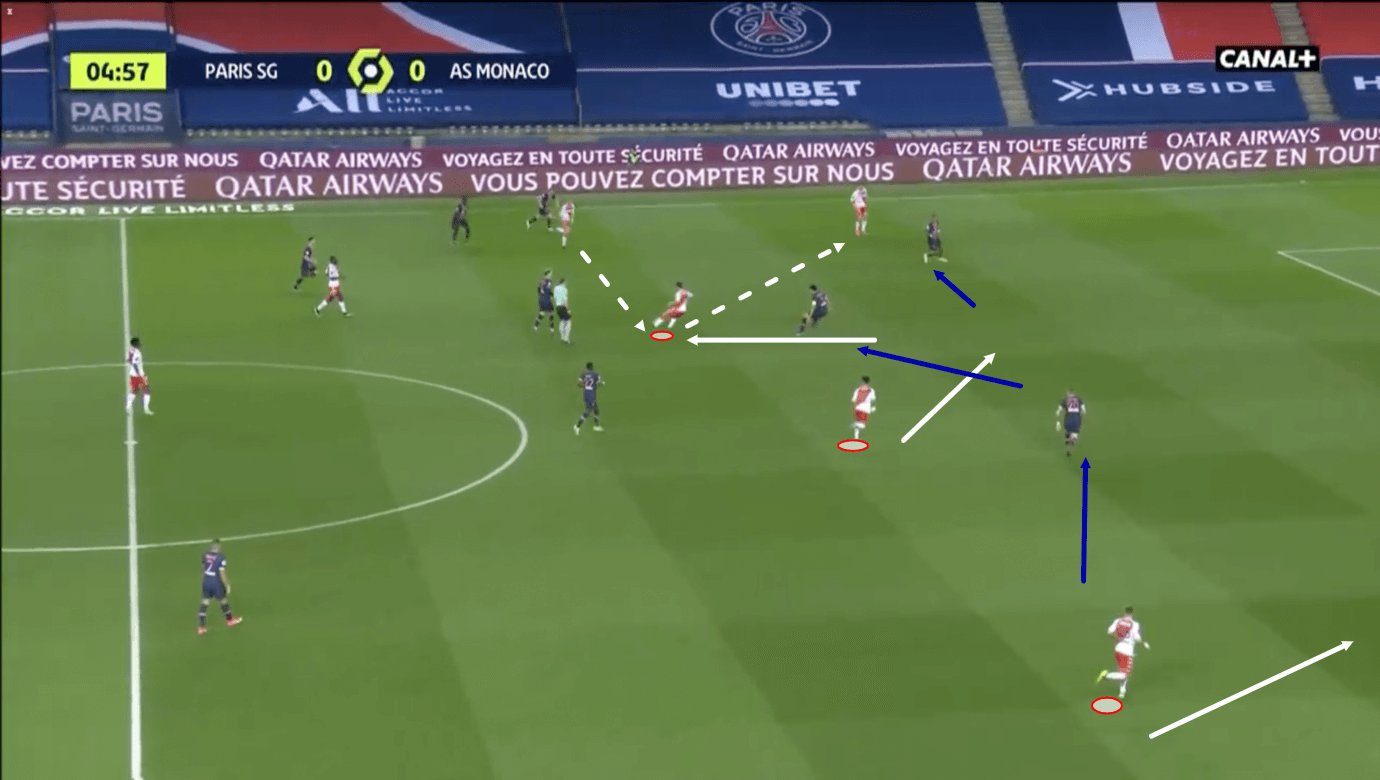
As this passage of play progressed into figure 9, we see that Monaco’s winger didn’t decide to play the ball straight through to the runner on this occasion, and instead decided to play the ball into the centre-forward, who dropped from his advanced position we saw him occupying in figure 8, to this ‘10’ position. By doing so, he and the winger helped Monaco to exploit another of the weaknesses we discussed regarding PSG’s defence – the space that opens up between their midfield and defensive lines.
The centre-forward received this pass and drew PSG’s centre-back out of the backline, creating another gap for a Monaco runner to target. Meanwhile, with PSG now using a three-man backline due to the right-back getting pulled out of position previously, Monaco’s right-winger also has acres of space to exploit, while the runner from the left half-space that we discussed in the previous image is in position to take PSG’s right centre-back on 1v1 on the wing.
It’s very common for Monaco’s centre-forward to drop like this, and Monaco’s half-space attackers do a great job of providing a presence in this position if the striker doesn’t. Given that PSG have struggled with defending this area at times this season, that makes Monaco a bad match-up for them. Expect Monaco to try and exploit space in this area as much as possible in the cup final, as it’s a strategy that worked very well for them in both of their league wins over the defending Ligue 1 and Coupe de France champions this term.
As play moves on, the centre-forward opts to make use of the runner on the left-wing who was ignored previously, which proved to be a wise move as this player successfully beat PSG’s right centre-back in a 1v1 out wide and managed to pull off a lethal cross to the back post – exploiting yet another one of the PSG weaknesses which we analysed in the previous section.
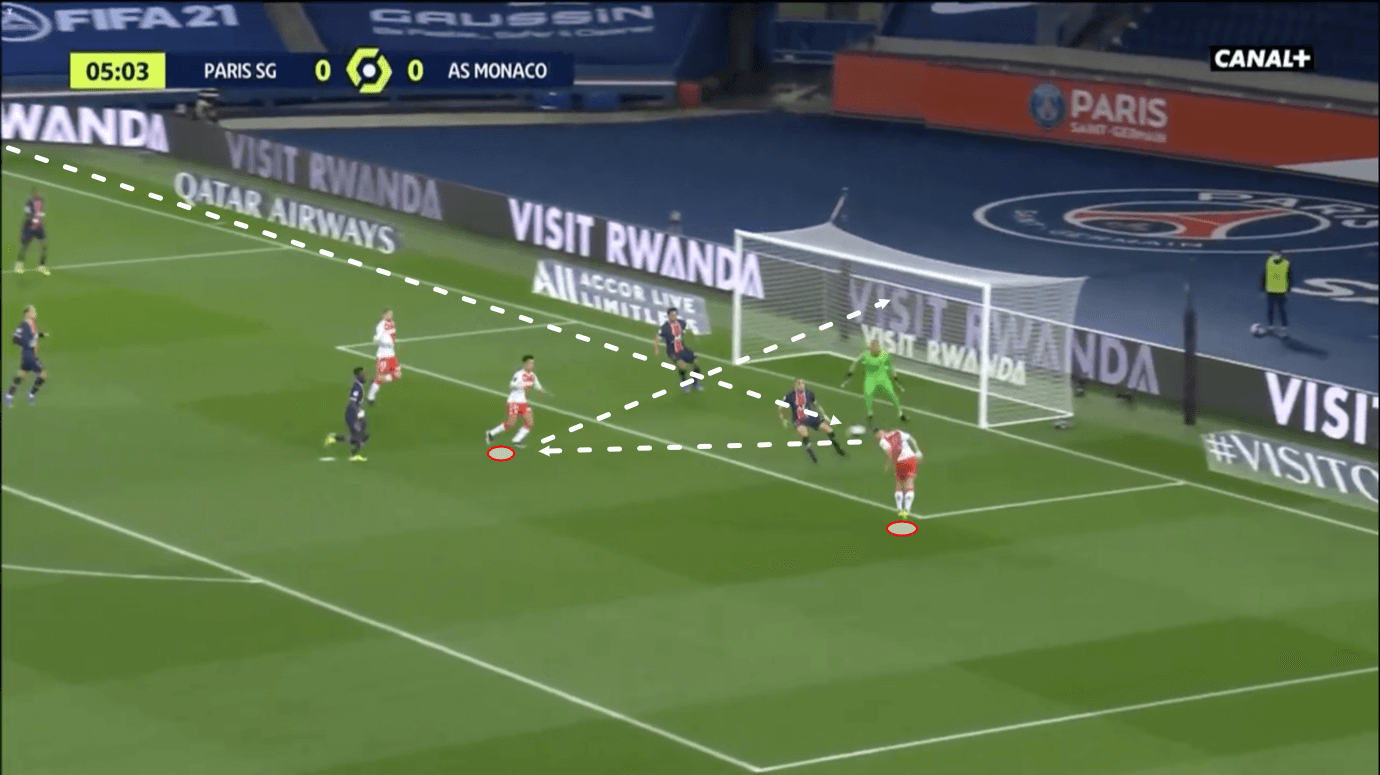
We see the result of this move in figure 10, where due to their backline becoming narrower with players getting pulled around by Monaco’s quick passing and movement, Les Monégasques found a free man at the back post who could put the ball on a plate for Sofiane Diop to score from a very good position, highlighting how effective these back post crosses can be against PSG.
This passage of play highlights the PSG weaknesses that we looked at in the previous section again, but also how Monaco have proven their ability to exploit them previously via their offensive tactics. They’re comfortable with playing through the wide men in the opposition half and their occupation of all five channels in the final third makes them very difficult to defend against for PSG’s backline when they beat the aggressive defending, which they often can thanks to their individual quality and their well-thought-out offensive moves.
PSG will have to succeed in plugging gaps in their backline, as well as between their backline and midfield line if they want to avoid conceding chances like this again on Wednesday, while their full-backs’ 1v1 defending will also be key to stopping Monaco from getting into these central areas despite the efforts of their midfielders and attackers at congesting midfield.
Monaco’s defence
While Monaco don’t press quite as aggressively as PSG, they’re not far off. They’ve got the second-lowest PPDA of any Ligue 1 side this season, indicating that they’ve got the second-most pressing intensity in France’s top-flight, trailing only PSG. In our next section of analysis, we’ll take a look at how Monaco are likely to shape up in defence on Wednesday, looking closely at their pressing tactics.
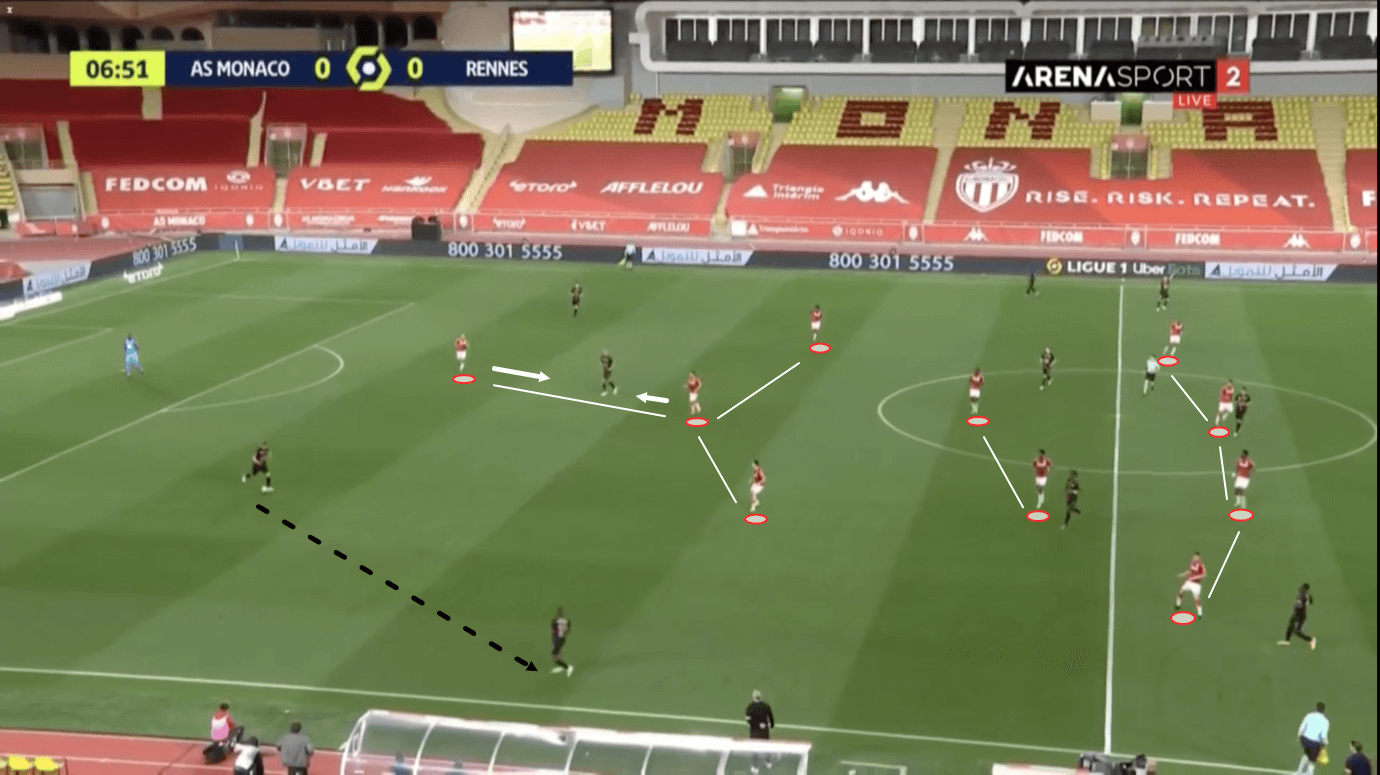
In figure 11, we see Monaco in a 4-2-3-1 shape. As mentioned previously, this is one of their more common defensive shapes, along with the 4-4-2 and 3-4-3. We expect to see Monaco in either a 4-4-2 or 4-2-3-1 for Wednesday’s cup final and we’ll use this example to demonstrate some of the prominent aspects of their defensive tactics when lined up in those systems.
Firstly, their shape is very narrow because, like PSG, they primarily aim to congest the centre of the pitch, preventing the opposition from playing through this area. While they tend to press aggressively, they also like to force the opposition out wide before really increasing the intensity of their press, which we can see in action in figure 11.
Here, Rennes’ right centre-back is on the ball without much pressure, but Monaco’s ‘10’ and centre-forward play a vital role in initiating the press by cutting off this player’s access to the other side of the pitch through their positioning. This effectively cuts the pitch in half and thanks to that, as well as the midfield congestion, the opposition are forced out wide. Once the full-back receives the ball, Monaco’s press becomes more aggressive. This is typical of their defensive tactics and we expect to see them try and play this way versus Paris.
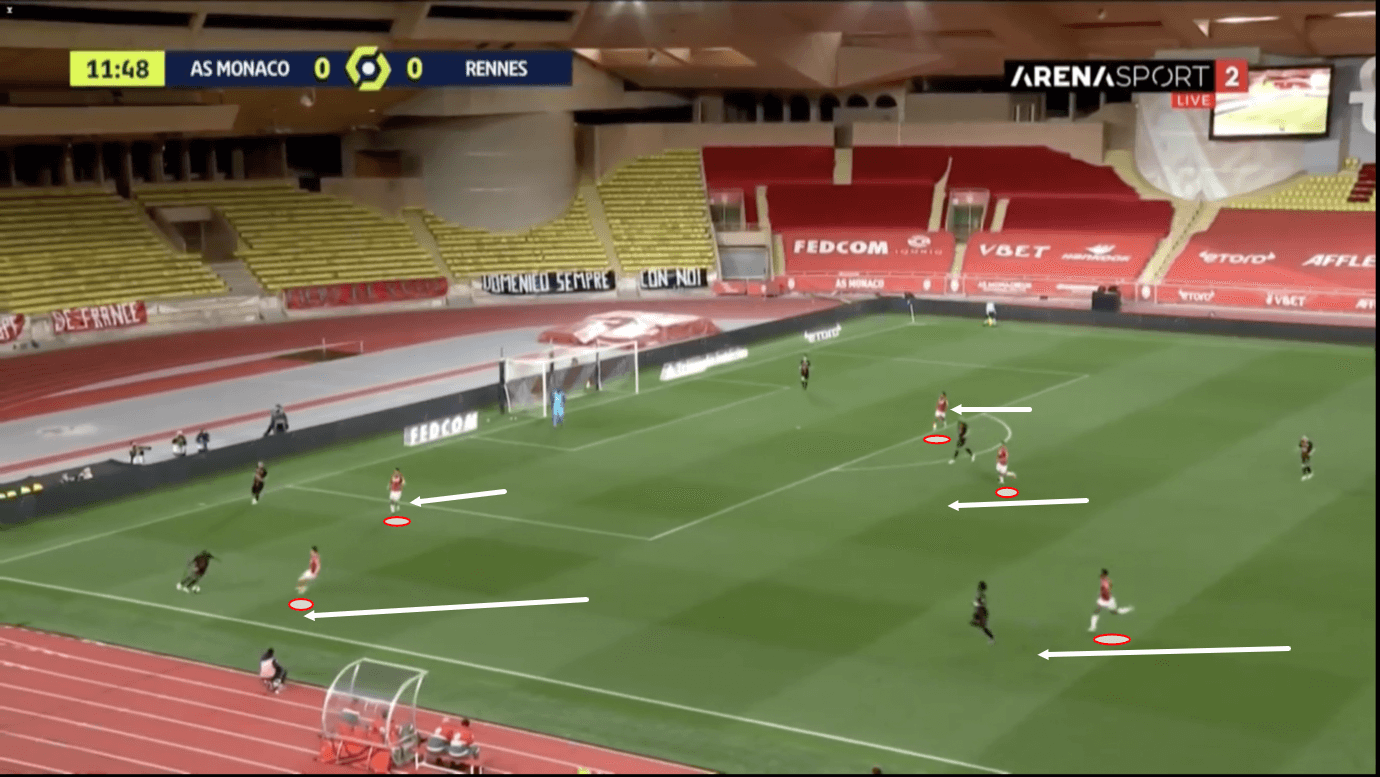
Figure 12 is from a different passage of play in this game versus Rennes to the previous image, but it provides a good example of how Monaco’s pressing intensity increases when the ball has moved out wide.
Knowing that they were playing with a 4-2-3-1 in this game, and just before this image the centre-back was on the ball, we see that as the right-back received possession, Monaco’s left-winger pushed out from the fairly central position we know that he occupies, to close down the full-back. While the ball-near winger closes down the full-back, Monaco’s centre-forward advances onto the nearest centre-back, blocking off that passing option. Les Monégasques’ ball-far winger comes inside to maintain access to the opposition’s other centre-back and holding midfielder, who’s also occupied by Monaco’s ‘10’, while it’s also common to see Monaco’s ball-near central midfielder advance to provide support to the winger, especially when the opposition central midfielder drops as we see here.
So, as Monaco’s press gets more aggressive in wide areas, their 4-2-3-1 becomes more like a very aggressive 4-1-4-1, as one central midfielder advances to provide support. These players crowd around the opposition ball carrier, marking the space around him and his nearest passing options. We expect to see Monaco pressing like this versus PSG. It might be difficult for PSG to exploit space opening up between the backline and midfield line due to the presence of the other central midfielder, who will remain deep and get central, though that is a possibility.
However, PSG can break this press and put Monaco in trouble through the dribbling quality of their full-backs when pressed aggressively by the Monaco winger, as well as the masterful movement of their off the ball players, which we’ll look at later on in this tactical analysis. PSG could also look to use the long passing ability of players like Marquinhos to exploit space on the opposite side of the pitch or in behind Monaco’s high line when they press aggressively. With the pace of Mbappé, this is always a very big threat, so that may not be a bad strategy, provided Monaco defend as we expect them to.
PSG’s attack
So, how will PSG shape up in attack on Wednesday? And what will they do to break Monaco’s press, overcome their defensive tactics, progress into the final third and create goalscoring opportunities? In this section, we’ll provide some analysis focusing on PSG’s offence and how we expect it to challenge Monaco on Wednesday, specifically taking a tactical look at their shape and their biggest attacking weapons.
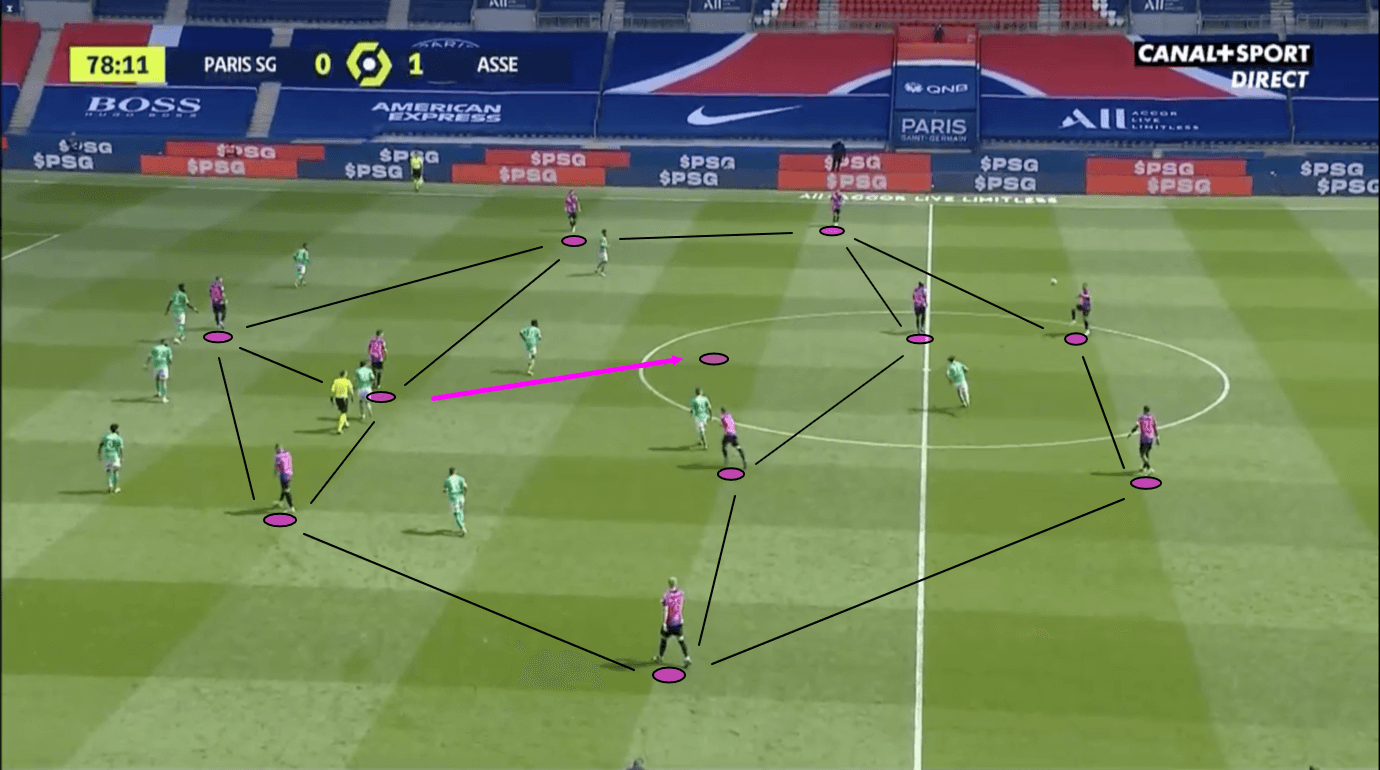
Figure 13 shows us how PSG tend to shape up on the ball, and how they’re likely to shape up on Wednesday. As mentioned previously, PSG defend in a 4-2-3-1, and unlike Monaco, their offensive shape doesn’t differ greatly from that. Their full-backs tend to advance to provide the width inside the final third, with PSG’s centre-backs and holding midfielders essentially forming a defensive box who hold to allow the others freedom in possession.
As the full-backs advance, PSG’s wingers come inside to occupy the half-spaces, supporting the ‘10’ and centre-forward, so their shape turns into something of a 2-2-5-1 as they progress into the final third. At the beginning of build-up and in the middle third of the pitch, as we see in figure 13, they shape up in more of a 2-4-3-1.
Pochettino’s side are generally patient in possession, with their centre-backs and holding midfielders – particularly Leandro Paredes – playing a very important role in ball progression. If PSG struggle to play past the opposition’s first line of defence and into midfield to find Paredes, the Argentinian has dropped between the two centre-backs at times this season, getting in front of the opposition’s first line of defence and losing any markers he has, to free himself up to be a very deep-lying playmaker.
This has proven very effective and while Paredes is certainly more useful in central midfield when it’s impossible to find him there, he can be very useful from the centre of a back three in possession thanks to his excellent passing range. Given that Monaco tend to congest the centre a lot, with the ‘10’ or centre-forward often marking an opposition holding midfielder, we imagine that Paredes may find himself in between the centre-backs at times on Wednesday during build-up. It will be difficult for Monaco to defend against him from this position.
Additionally, it’s been common to see PSG’s ‘10’ drop deep in a similar way to how Paredes drops, except instead of splitting the centre-backs, he splits the central midfielders, boosting PSG’s presence in central midfield, helping them to create an overload, and finding more space than he had in the more advanced position by losing a marker – similarly to Paredes. In figure 13, for example, PSG’s ‘10’ dropped as the passage of play moved on, losing the player who we can see tightly marking him in this image and helping his side to create a 3v2 advantage over the opposition’s central midfielders.
Like Paredes, this player – often Neymar or Verratti, but with both players like to be absent for Wednesday’s game, possibly Rafael Alcântara or Julian Draxler – is generally an accomplished playmaker and when they find space in the deeper position, they can either carry it forward themself, creating a panic for the opposition in the final third and potentially creating space for teammates by attracting pressure, or play the ball through to a more advanced teammate in a good position. This is a common tactics for PSG under Pochettino and we expect to see them try and do this on Wednesday.
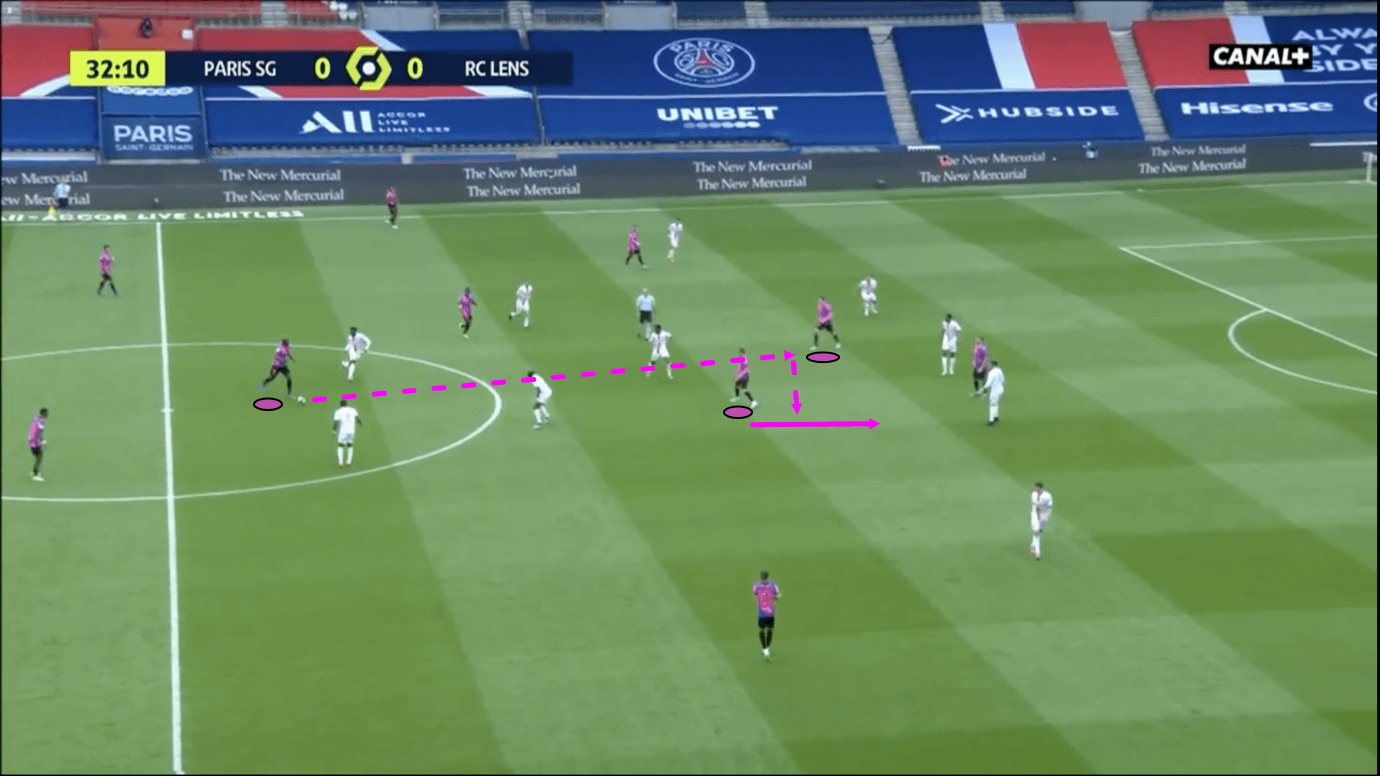
Verticality is a huge part of PSG’s game in possession. While they tend to be patient in the early stages of build-up, as they progress towards the opposition half they cut down more and more on their lateral passing, with a clear emphasis on trying to play the ball vertically. We see an example of one such occasion in figure 14, where PSG’s ball carrier in the holding midfield position is trying to find the attacker circled to his right, but because that passing lane is blocked off, he’s unable to do so. As a result, the ball carrier took an extra couple of touches, allowing the attacker circled to his left to drop and essentially become the third man, helping Les Parisiens to get around the opposition’s defensive efforts and get the ball to the other attacker who was being blocked off previously.
PSG are constantly putting together passing moves like this where they progress vertically through the thirds to get their very talented attackers on the ball, facing the opposition’s goal inside the final third. That’s essentially their main tactical aim in possession.
PSG are often given a lot of space out wide, at the expense of space in central areas, however, they’re often unable to make use of this space out wide because they often lack a great aerial threat inside the penalty area and some of their crossing from wide areas can be wasteful at times. It’s proven a successful defensive tactic for teams to congest the centre inside their own third versus PSG, allowing Les Parisiens to have acres of space out wide, knowing that they will struggle to use that space effectively.
This is why Pochettino’s got his side focusing so much on playing vertically through the lines to get his plethora of talented playmakers on the ball facing the opposition goal in the ‘10’ position or the half-space and we expect to see them try to do this versus Monaco. Due to their quality on the ball and their off the ball movement, it will be difficult for Monaco to stop them from doing this entirely, but Monaco also have good organisation and solid defensive tactics designed to prevent central ball progression, so this will be another interesting area of battle.
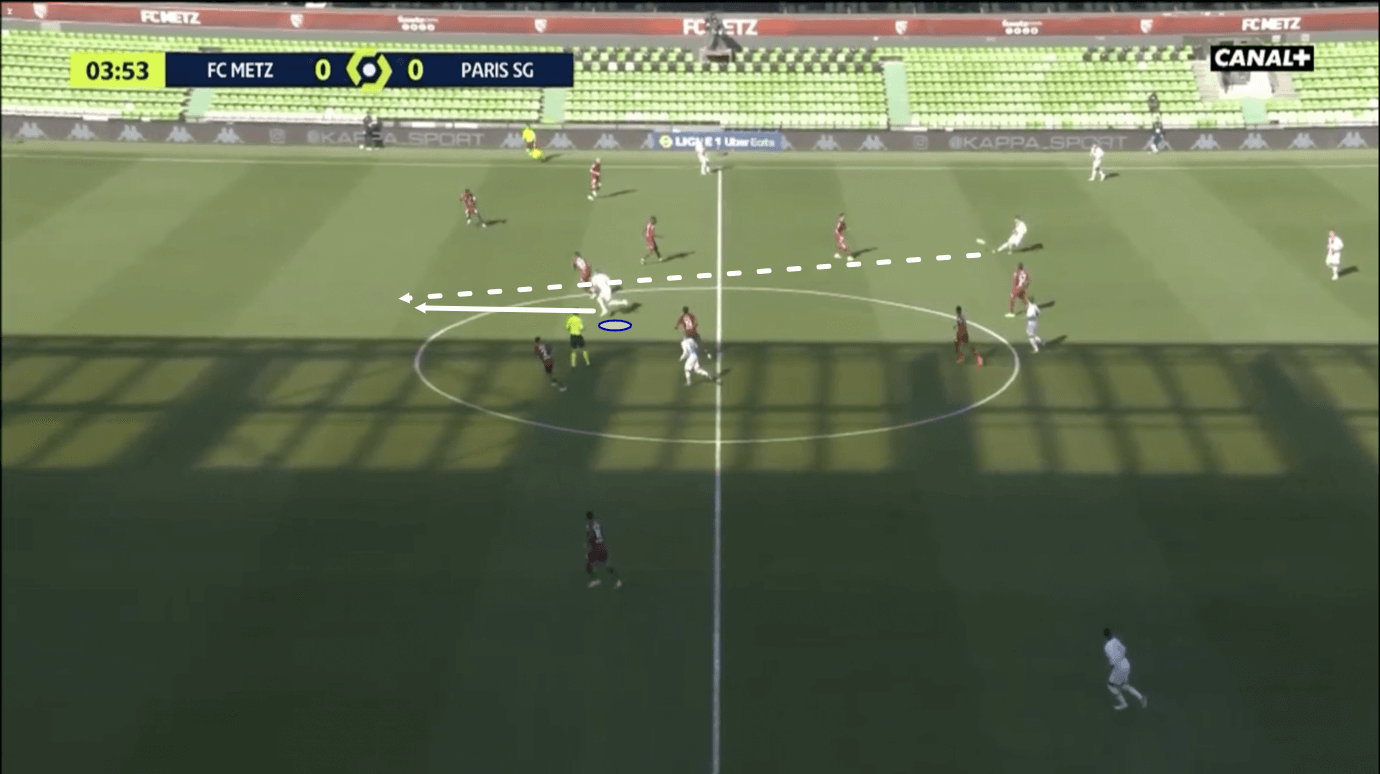
Lastly, as we mentioned in the previous section, Monaco tend to deploy quite a high line, especially when pressing high, and PSG have the ability to exploit that through Mbappé, who’s got pace to burn when running in behind and is a constant threat against high defensive lines, as was the case in figure 15, where we see PSG playing him in on goal with a lofted through ball from deep.
Mbappé will be making runs designed to exploit Monaco’s high defensive line, provided that they do press as aggressively as they often do, throughout Wednesday’s cup final, and we expect the likes of Marquinhos and Paredes to be constantly looking out for his movement from deep. Monaco’s pressing to close down these deep-lying playmakers will be key to avoiding conceding chances like this.
Conclusion
To conclude this tactical analysis, in the form of a tactical preview, both Monaco and PSG possess a lot of tools that can hurt the other team. Monaco haven’t taken six points from PSG this season by fluke – they are a side whose tactics naturally exploit some of PSG’s biggest weaknesses. However, PSG aren’t in this final and sitting above Monaco on the Ligue 1 table by accident either – they will present a formidable challenge to their opponents in the Coupe de France final.
This game will see some very interesting tactical battles all over the pitch, notably with PSG’s pressing versus Monaco’s build-up and vice versa, with both teams likely to press aggressively while blocking off ball progression through the centre. Given that Monaco have exploited plenty of PSG’s major weaknesses already this season, the ball may well be in their court heading into this one, despite their trophy drought.





Comments